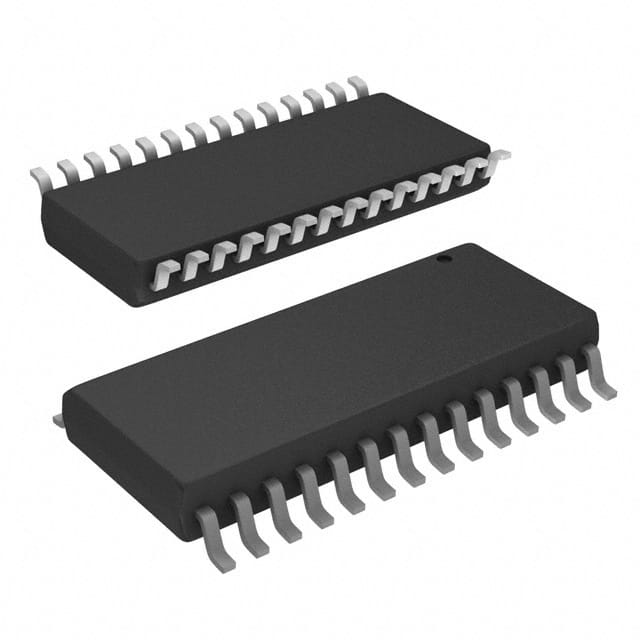Voir les spécifications pour les détails du produit.

ST72C104G1M6
Product Overview
Category
The ST72C104G1M6 belongs to the category of microcontrollers.
Use
This microcontroller is commonly used in various electronic devices and systems for control and processing purposes.
Characteristics
- High-performance 8-bit microcontroller
- Low power consumption
- Integrated memory and peripherals
- Wide operating voltage range
- Enhanced security features
Package
The ST72C104G1M6 is available in a compact and durable package, suitable for surface mount technology (SMT) applications.
Essence
The essence of the ST72C104G1M6 lies in its ability to provide efficient control and processing capabilities within a small form factor.
Packaging/Quantity
This microcontroller is typically packaged in reels or trays, with quantities varying based on customer requirements.
Specifications
- Architecture: 8-bit
- CPU Frequency: Up to 16 MHz
- Program Memory Size: 4 KB
- RAM Size: 256 bytes
- Operating Voltage Range: 2.7V to 5.5V
- Number of I/O Pins: 20
- Communication Interfaces: UART, SPI, I2C
- Timers/Counters: 2
- Analog-to-Digital Converter (ADC): 8 channels, 10-bit resolution
Detailed Pin Configuration
The ST72C104G1M6 has a total of 20 pins, each serving a specific purpose. The pin configuration is as follows:
- VDD - Power supply voltage
- PA0 - General-purpose I/O pin
- PA1 - General-purpose I/O pin
- PA2 - General-purpose I/O pin
- PA3 - General-purpose I/O pin
- PA4 - General-purpose I/O pin
- PA5 - General-purpose I/O pin
- PA6 - General-purpose I/O pin
- PA7 - General-purpose I/O pin
- PB0 - General-purpose I/O pin
- PB1 - General-purpose I/O pin
- PB2 - General-purpose I/O pin
- PB3 - General-purpose I/O pin
- PB4 - General-purpose I/O pin
- PB5 - General-purpose I/O pin
- RESET - Reset pin
- VSS - Ground
- OSCIN - Oscillator input
- OSCOUT - Oscillator output
- VDD - Power supply voltage
Functional Features
- High-speed processing capabilities
- Flexible I/O configuration
- Built-in communication interfaces for seamless connectivity
- On-chip memory for program and data storage
- Timers/counters for precise timing operations
- Analog-to-digital converter for sensor interfacing
- Enhanced security features for protection against unauthorized access
Advantages and Disadvantages
Advantages
- Compact size and low power consumption make it suitable for portable devices
- Wide operating voltage range allows for compatibility with various power sources
- Integrated peripherals reduce the need for external components
- Enhanced security features provide protection against potential threats
Disadvantages
- Limited program memory size may restrict the complexity of applications
- 8-bit architecture may not be sufficient for certain high-performance applications
- Limited number of I/O pins may limit the connectivity options in complex systems
Working Principles
The ST72C104G1M6 operates based on an 8-bit architecture, where instructions are executed sequentially. It utilizes a combination of hardware and software to perform tasks such as data processing, control, and communication. The microcontroller fetches instructions from its program memory, processes them using its central processing unit (CPU), and interacts with external devices through its I/O pins and communication interfaces.
Detailed Application Field Plans
The ST72C104G1M6 finds applications in various fields, including but not limited to:
- Consumer Electronics: Used in remote controls, smart home devices, and portable gadgets.
- Industrial Automation: Employed in control systems for machinery, robotics, and process automation.
- Automotive: Integrated into automotive electronics for engine management, dashboard controls, and safety systems.
- Medical Devices: Utilized in medical equipment for monitoring, diagnostics, and treatment purposes.
- Internet of Things (IoT): Incorporated into IoT devices for data acquisition, processing, and connectivity.
Detailed and Complete Alternative Models
- ST72F264G2M6: Similar microcontroller with enhanced memory and peripheral capabilities.
- STM8S003F3P6: Alternative microcontroller with lower power consumption and compact package size.
- PIC16F877A: Microcontroller from a different manufacturer, offering similar features and performance.
- ATmega328P: Popular microcontroller with a wide range of development tools and community support.
These alternative models provide similar
Énumérez 10 questions et réponses courantes liées à l'application de ST72C104G1M6 dans les solutions techniques
Sure! Here are 10 common questions and answers related to the application of ST72C104G1M6 in technical solutions:
Q1: What is the ST72C104G1M6 microcontroller used for? A1: The ST72C104G1M6 microcontroller is commonly used in various technical solutions, including industrial automation, consumer electronics, automotive applications, and more.
Q2: What is the maximum clock frequency supported by the ST72C104G1M6? A2: The ST72C104G1M6 microcontroller supports a maximum clock frequency of 8 MHz.
Q3: How much flash memory does the ST72C104G1M6 have? A3: The ST72C104G1M6 microcontroller has 4 KB of flash memory.
Q4: Can I use the ST72C104G1M6 for analog signal processing? A4: No, the ST72C104G1M6 is a digital microcontroller and does not have built-in analog signal processing capabilities. However, it can interface with external analog components.
Q5: What communication interfaces are available on the ST72C104G1M6? A5: The ST72C104G1M6 microcontroller supports UART (Universal Asynchronous Receiver-Transmitter) and SPI (Serial Peripheral Interface) communication interfaces.
Q6: Does the ST72C104G1M6 have any built-in timers? A6: Yes, the ST72C104G1M6 microcontroller has two 8-bit timers that can be used for various timing and control purposes.
Q7: Can I program the ST72C104G1M6 using C language? A7: Yes, the ST72C104G1M6 microcontroller can be programmed using the C language, along with the appropriate development tools and software.
Q8: What is the operating voltage range of the ST72C104G1M6? A8: The ST72C104G1M6 microcontroller operates within a voltage range of 2.7V to 5.5V.
Q9: Does the ST72C104G1M6 have any built-in analog-to-digital converters (ADCs)? A9: No, the ST72C104G1M6 does not have any built-in ADCs. However, it can interface with external ADCs if required.
Q10: Can I use the ST72C104G1M6 in battery-powered applications? A10: Yes, the low power consumption characteristics of the ST72C104G1M6 make it suitable for battery-powered applications where energy efficiency is important.
Please note that these answers are based on general information about the ST72C104G1M6 microcontroller and may vary depending on specific application requirements.

